Stories about place names in Aotearoa New Zealand
Discover stories about place names with your class. Use our new ‘Social sciences topic starters for Years 0–3’ for inspiration.
What stories do you know about place names?
Place names are a great way to get ākonga interested in their local history. Many ingoa wāhi (place names) across the motu (country) tell us stories about people, places and events. We are all familiar with some ingoa wāhi — whether it is the town or city you live in, geographical features or the names of roads and streets in your rohe (local area).
While we all know some ingoa wāhi, do you know what those place names mean or the story about how the place got its name? Having grown up in Waiuku, I have always known it means stream with banks of white clay. But how did Waiuku get its name? (We'll come back to this later).
There are many rich stories about places across Aotearoa New Zealand. Some places have more than one story, while some stories have changed or may have been lost over time.
Whanganui River and Taranaki Maunga are examples of ingoa wāhi that have reverted to their original te reo Māori name as part of our country's journey towards honouring and enacting Te Tiriti o Waitangi. The naming of geographical features, cities and towns can generate discussions about who gets to name places. Or, which places have Māori names and which places reflect colonial or settler names.
National Library Services to Schools has recently launched a new teaching resource for ākonga to explore the diverse histories and experiences of people, places and events of Aotearoa New Zealand.
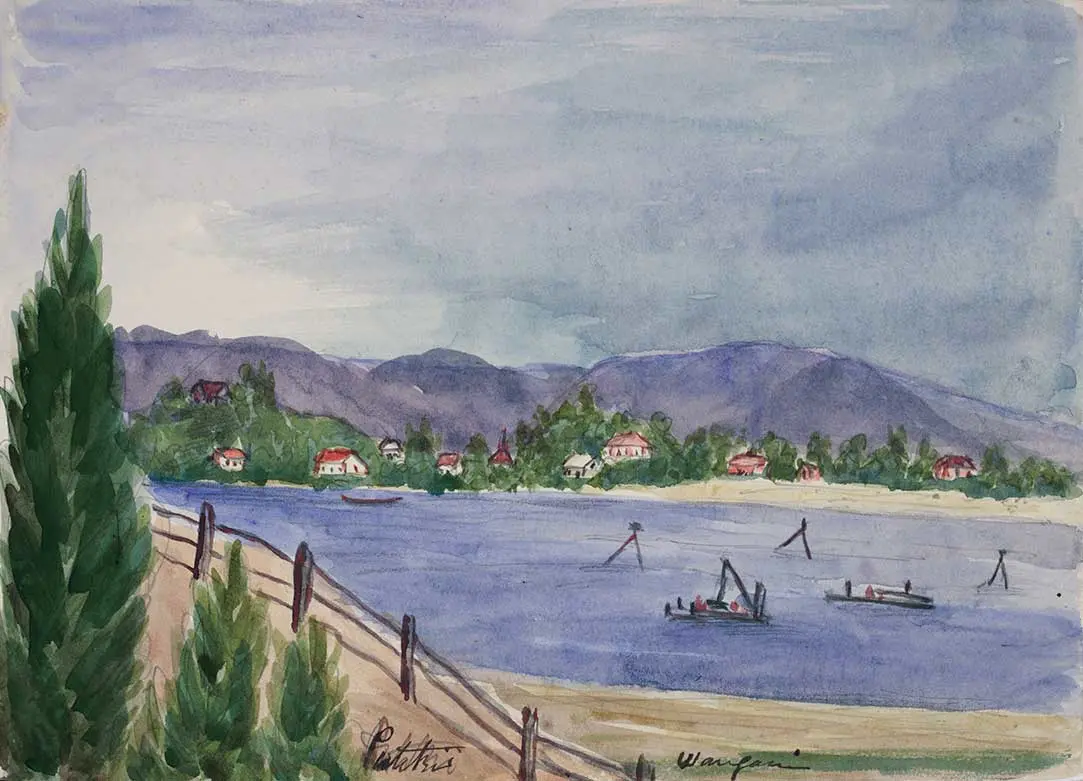
Image credit: Putiki, Wanganui, ca 1896–1899 by Mary Catherine (Taylor) Medley. Ref: E-380-011 Alexander Turnbull Library.
Social sciences topic starters for Years 0–3
We have developed five topic starters to support the learning of te ao tangata | social sciences curriculum. Topic starters include the significance of Waitangi Day, living and working in Aotearoa New Zealand and stories about places in Aotearoa New Zealand.
Images are a great way to engage ākonga in Aotearoa New Zealand's histories. Each topic starter includes a selection of images such as photos, artworks and maps. Teacher support materials are available to download or view an accessible version online.
For each image, we provide a description and discussion starters to spark curiosity and generate conversations about our past. Our librarians have also selected a list of picture books for each topic which are available to borrow from our school lending service.
Check out our new teaching resource: Social sciences topic starters for Years 0–3.
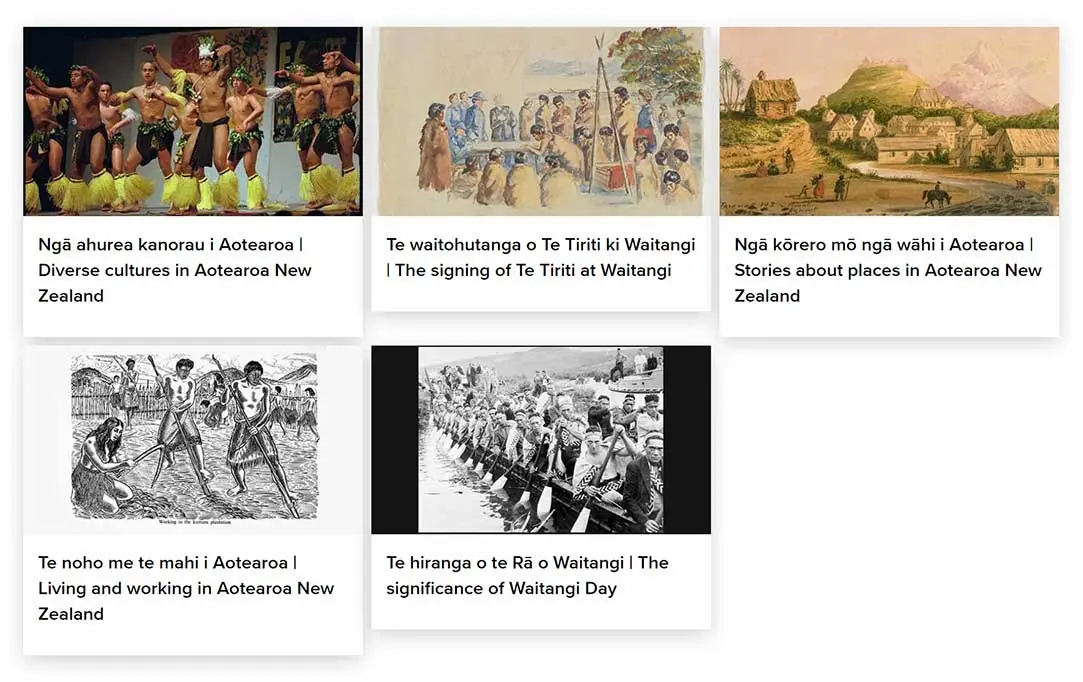
The longest place name
We're giving you a taster below of three images from our topic starter ‘Ngā kōrero mō ngā wāhi i Aotearoa | Stories about places in Aotearoa New Zealand’. This topic supports the learning of the social sciences Know context, ‘Te tūrangawaewae me te taiao | Place and environment’:
Many of the names of geographical features, towns, buildings, streets, and places tell stories. Sometimes there is more than one story.
— Te ao tangata | social sciences
The first image we're sharing is a sign of the longest place name. This photo is a great way to spark curiosity about ingoa wāhi and what they might mean.
‘Taumatawhakatangihangakoauauotamateaturipukakapikimaungahoronukupokaiwhenuakitanatahu’ is one of the longest place names in the world. The name in English means ‘The hilltop, where Tamatea with big knees, conqueror of mountains, eater of land, traveller over land and sea, played his kōauau (flute) to his beloved’.

Image credit: Taumatawhaka-tangihangakoauau-atamateapokai-whenuakitanatahu sign, 1948 by E. P. Christensen. Archives New Zealand on Flickr. Some rights reserved: CC BY 2.0.
Discussion starters
Use the following prompts and discussion starters to engage ākonga with this photo:
Can you have a go at saying the longest place name in Aotearoa New Zealand?
What is the longest place name in your rohe?
What stories do you know about place names?
Khandallah station
Some places tell stories about diverse cultures who have settled in Aotearoa New Zealand.
Use the following photo of Khandallah railway station in Te Whanganui-a-Tara | Wellington to spark conversations around settler place names in Aotearoa New Zealand.
There are different stories about the naming of Khandallah. One version is that Captain James Andrew, who had served in the Indian Army, gave the area its Indian name (after Khandela in India). Street names in the suburb have continued this tradition.
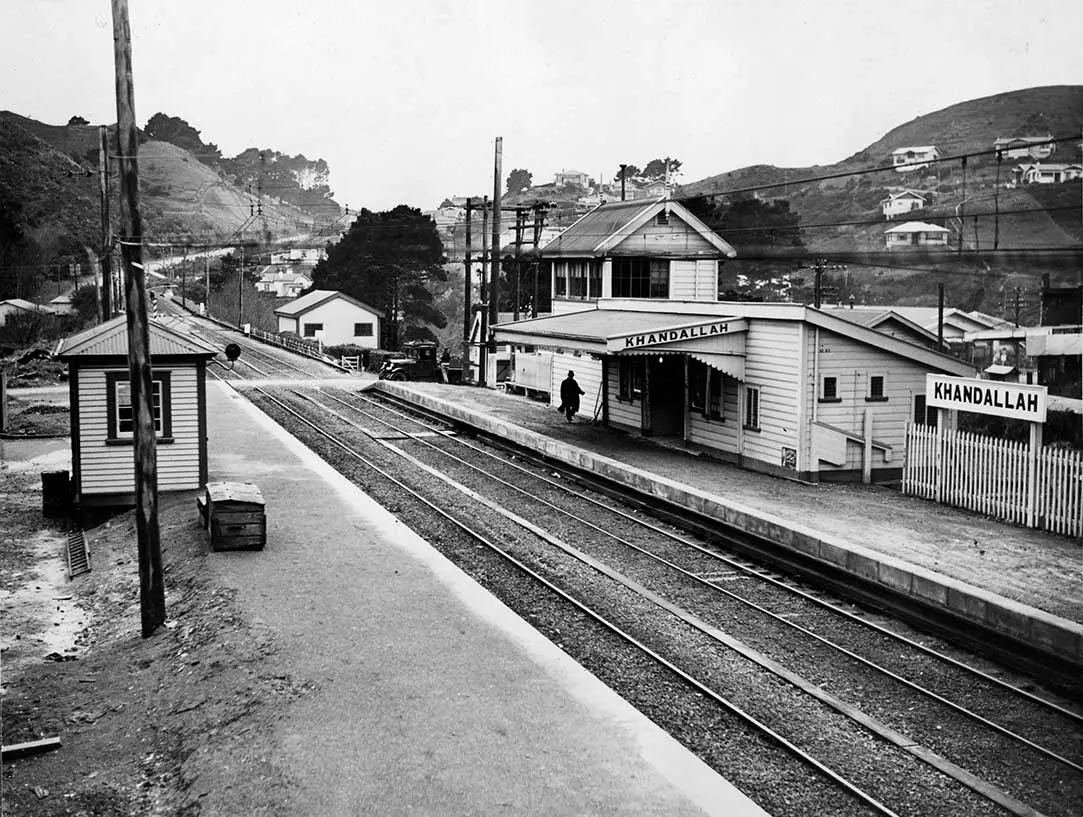
Image credit: Khandallah railway station, 1938 by unidentified Evening Post photographer. Ref: PAColl-5482-013 Alexander Turnbull Library.
Discussion starters
Use the following discussion starters with ākonga to brainstorm settler place names:
Can you think of any towns, streets or places in Aotearoa New Zealand that have Indian names?
What other places are named after different groups of settlers who have come to Aotearoa New Zealand?
Here are a few examples of Indian place names from across the motu:
Cashmere in Ōtautahi | Christchurch
The Bombay Hills south of Tāmaki Makaurau | Auckland
Surat Bay in Southland.
Also, here are some street names that reflect different groups of people who have made Aotearoa New Zealand home:
Tory Street in Te Whanganui-a-Tara | Wellington
Jonah Lomu Drive in Paerata
Jean Hing Place on the Kāpiti Coast.
Use images to foster critical thinking skills
The images in our social sciences topic starters are rich historical sources. You can pair these images with our primary source analysis tools.
National Library Services to Schools has developed three levels of tools (explore, analyse and critically analyse). The explore tools have easy-to-follow prompts, simple language and icons designed to spark curiosity. It's a great first step into primary source analysis.
The third image we'll show you is a painting of Taranaki Maunga from our ‘Stories about places in Aotearoa New Zealand’ topic starter.
Below, we'll walk you through an exemplar of our explore a mahi toi | artwork tool in action. You'll see how the painting of Taranaki Maunga can be analysed in three easy steps.
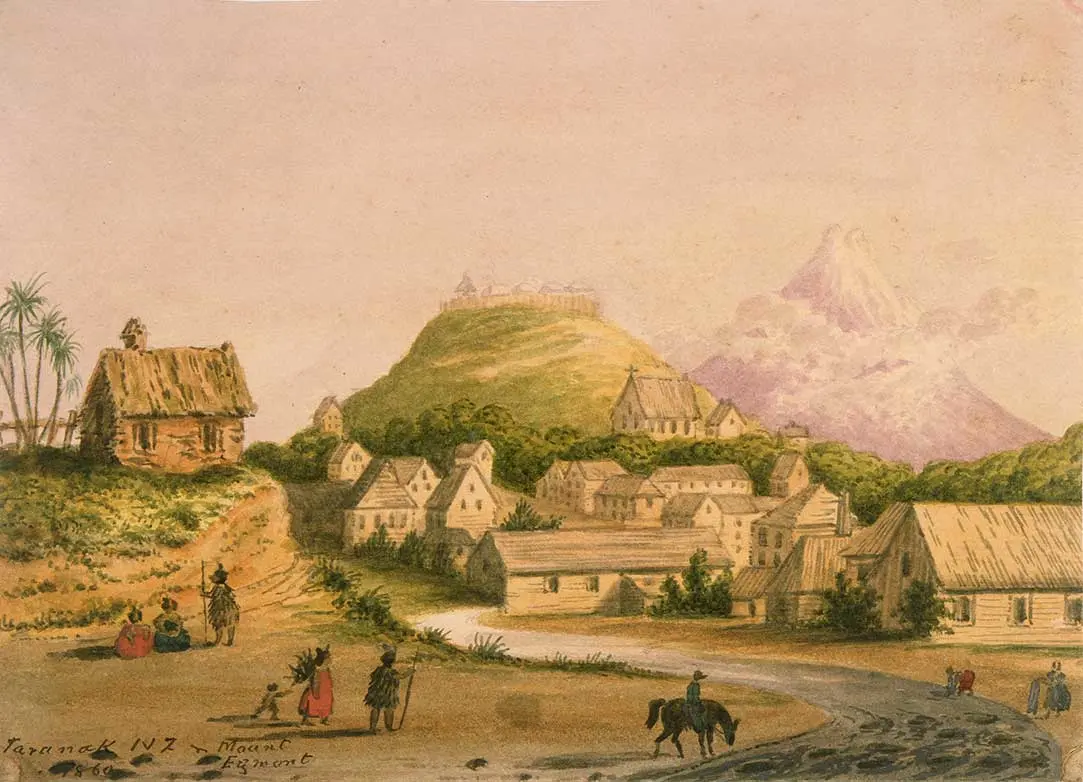
Image credit: Taranaki, N.Z. Mount Egmont 1860 by Charles Emilius Gold. Ref: A-288-012 Alexander Turnbull Library.
Āta tirotiro | Observe
The first step supports ākonga to develop their observation skills. Ākonga will follow the prompts to identify the type of artwork (a painting).
The next set of prompts guides ākonga to scan the artwork for people, places, objects or events. Ākonga may observe people such as a whānau, a person on horseback and two women doing washing in the stream. Buildings or a town/settlement and a maunga (mountain) are examples of places.
The tool also prompts ākonga to look for information in the artwork's caption. For example, they can find the artist's name (Charles Emilius Gold), when the painting was created (1860) and the location (Taranaki).
Urupare | Respond
Step two encourages ākonga to generate a personal response, such as their feelings and thoughts about the artwork. The artwork may invoke feelings of happiness or curiosity. Or it may remind ākonga of a maunga they are connected to.
Ākonga can also create their own drawing of the artwork in the space provided. This supports deeper observation to ask critical questions in the next step.
Whakaaroaro | Reflect
The final step encourages ākonga to ask questions and plan how to find out the answer.
Ākonga may have noticed earlier that the name Mt Egmont was used in the title of the painting. They might be curious to know why the name of the maunga changed or what the names mean.
Ākonga may decide to ask their whānau for help to access trusted websites to discover why Taranaki Maunga was called Mt Egmont.
This painting could also be used to explore how the way we work and live has changed over time. Ākonga can look for clues in the artwork, such as the type of clothing worn, transport options (horse) and the women washing clothes in the stream.
An exemplar of the Explore a mahi toi | artwork tool.
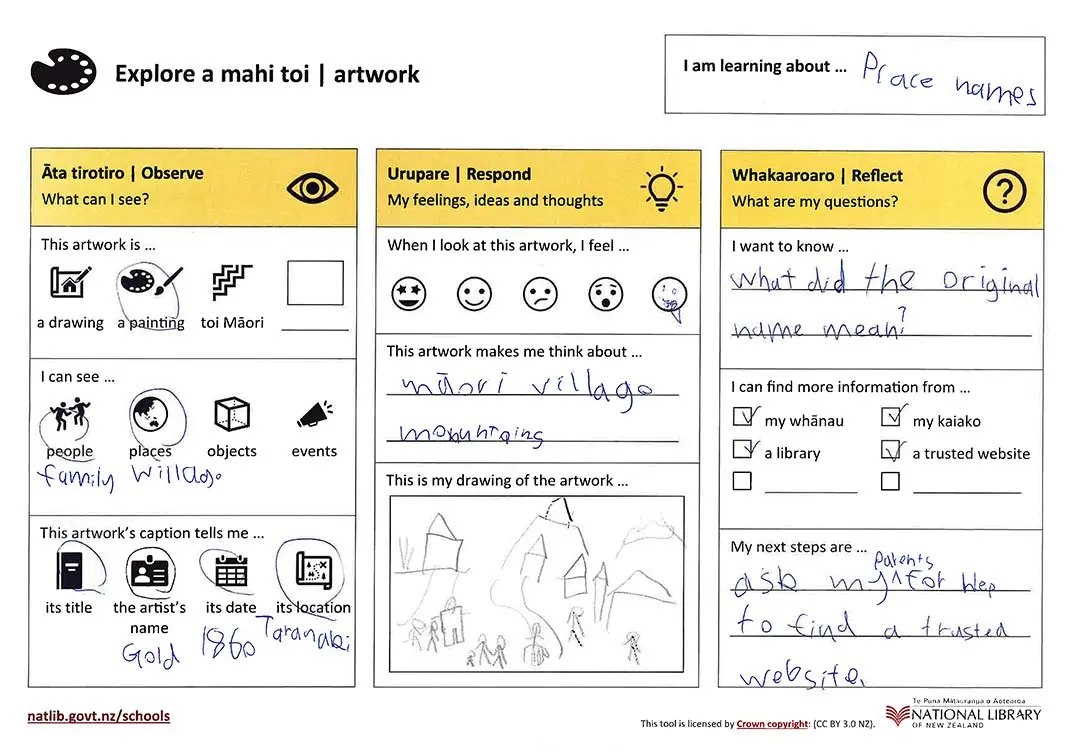
Long description — responses in ‘Explore a mahi toi | artwork’ exemplar
Ākonga responses in the exemplar are as follows.
I am learning about
Place names.
Āta tirotiro | Observe
This artwork is: a painting.
I can see: people (family), places (village).
This artwork's caption tells me: its title, the artist's name (Gold), its date (1860), it's location (Taranaki).
Urupare | Respond
When I look at this artwork, I feel: (interested/hmmm).
This artwork makes me think about: Māori village mountains.
This is a drawing of my artwork: (pencil drawing showing people and buildings in a village).
Whakaaroaro | Reflect
I want to know: what did the original name mean?
I can find more information from: my whānau, my kaiako, a library, a trusted website.
My next steps are: ask my parents for help to find a trusted website.
Resources to support learning about ingoa wāhi
Use these resources to explore place names with your class. They are a great starting point, with engaging images and discussion starters, primary source analysis tools, inquiry support and a pronunciation guide:
Ngā kōrero mō ngā wāhi i Aotearoa | Stories about places in Aotearoa New Zealand
AnyQuestions — a free online chat service that helps ākonga with their questions
Which place names will you explore first?
There are so many ingoa wāhi to explore! Which one will you choose first?
Use our topic starter ‘Ngā kōrero mō ngā wāhi i Aotearoa | Stories about places in Aotearoa New Zealand’ for inspiration.
I will leave you with one of the stories behind the name of my hometown, Waiuku. This is a version of the story I grew up hearing. I hope it will inspire you to discover more stories about ingoa wāhi with your class.
Stream with banks of white clay. A puhi (girl of high rank) came here to choose a husband. The first chief to be presented to her did not impress her despite his good looks, so the family hastily summoned his brother, who was working in the kumara plantation. He scrubbed himself with white clay from the river to make himself presentable (uku was at one time known as 'Māori soap').
— Waiuku, NZHistory